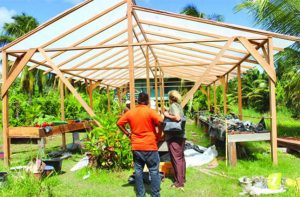FARMERS from across the country have been turning to shaded cultivation as part of their efforts to combat climate change and practice climate-smart agriculture.
With changing weather patterns and unpredictable weather conditions, farmers have been forced to innovate in order to maintain their yields and productivity.
One of those innovations is shade-house farming, which according to Director of National Agricultural Research and Extension institute (NAREI), Dr. Odhu Homenauth, has taken off all across the country.
“A lot of women folk are involved in this activity… it has contributed significantly to farmers and you can produce year-round and you get better yields,” said Dr. Homenauth during an exclusive interview with the Guyana Chronicle on Monday.
As touted by many institutions, particularly the Office for Climate Change, farmers need to adopt a more “climate-smart” approach to agriculture, especially now that the changes in weather patterns have become unusual because of global warming.
Dr. Homenauth said climate-smart agriculture is basically a practice which farmers utilise to adapt to the changing weather patterns.
“We will have extended droughts and have periods of intense rainfall… in other words, what falls in three days can fall in half hour and that’s terrible,” he said.

As the global phenomenon intensifies, Dr. Homenauth said the institute intends on working with farmers and promoting climate-smart agriculture in local farming communities.
Aside from shade houses, part of the effort includes promoting agro-processing, which features significantly in the hinterland areas.
Dr. Homenauth said there is also a need to establish banks or areas where there is irrigation, because once there is irrigation, farmers can maintain their planting materials, instead of waiting for a period of drought or rain to end.
Farmers can also invest in nurseries so that they can have seedlings available when they are ready to cultivate.
Specialists say that climate-smart agriculture is a business model that increases agricultural output, while maintaining, or lowering, amounts of inputs, such as land, water or fertiliser.
It also increases total productivity, while reducing environmental impacts and building resilience to threats to production induced by the effects of climate change.
In 2015, the Inter-American Development Bank (IDB) announced the approval of US$5M for a Climate-Smart Agriculture Fund (CSAF) for the Caribbean and Latin America to encourage private sector companies in the Region to invest in projects that increase farmers’ incomes while addressing climate change.



.jpg)










